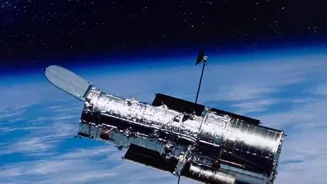Unraveling the Mysteries of Cosmic Microwave Background Radiation: 10 Mind-Blowing Facts That Will Challenge Your Universe! Dive in and expand your cosmic knowledge
The Cosmic Microwave Background (CMB)
radiation. It’s a mouthful, we know! But trust us, this faint glow permeating the entire universe is way more interesting than it sounds. It’s the afterglow of the Big Bang, the very fiery birth of our cosmos.
Scientists have been studying it for decades, and guess what? It's still throwing up surprises! Forget what you think you know about space. We're diving headfirst into 10 facts about the CMB that will make you question everything. Prepare to have your cosmic perceptions turned upside down!
The CMB is a snapshot of the baby universe at 380,000 years
The CMB is like a baby picture of the universe, taken when it was only 380,000 years old. Now, that's just a blink of an eye in cosmic time! Back then, the universe was a super-hot, dense plasma. Imagine a cosmic soup of protons, neutrons, and electrons all bouncing around like crazy.
Light couldn’t travel freely because it kept bumping into these particles. As the universe expanded and cooled, these particles eventually combined to form neutral atoms, and finally, light could travel freely, giving us the CMB we see today.
Isn’t it wild to think that we are seeing light that has traveled across billions of years?
Theory of inflation explains uniformity of CMB due to rapid expansion
Did you know that the CMB is incredibly uniform, having almost the same temperature in all directions?
Scientists were initially baffled by this because, according to our understanding of physics, the different regions of the early universe shouldn't have had enough time to interact and equalize their temperatures.
This led to the development of the theory of "inflation," which proposes that the universe underwent a period of extremely rapid expansion in its earliest moments, allowing these regions to come into thermal equilibrium before expanding beyond each other’s reach.
Inflation helps explain why space-time seems to be flat and why the temperature of the CMB is generally homogenous.
CMB fluctuations seed universe's structures, vital for galaxies
The CMB isn't perfectly uniform; it has tiny temperature fluctuations, or temperature variations. These fluctuations may be minute, but they are incredibly important because they represent the seeds of all the structures we see in the universe today, such as galaxies, galaxy clusters, and even us!
These tiny density fluctuations in the early universe acted as gravitational wells, attracting more and more matter over time. Eventually, these regions became dense enough to collapse under their own gravity, forming the structures we observe today.
Without the CMB fluctuations, the universe would be an empty, structureless void.
CMB reveals universe's composition with dark matter, energy
The CMB is not just a faint glow; it also carries information about the composition of the universe. Specifically, the pattern of temperature fluctuations in the CMB tells us the relative amounts of ordinary matter, dark matter, and dark energy in the universe.
Ordinary matter makes up only a small percentage of the total energy density of the universe. Most of the universe is made up of dark matter and dark energy, which we can't directly see but can infer their presence through their gravitational effects of the CMB, making the research valuable.
Prediction of cosmic microwave background confirmed by Penzias and Wilson
The CMB’s existence was predicted way back in the 1940s by George Gamow, Ralph Alpher, and Robert Herman. They were working on the theory of Big Bang nucleosynthesis, which explains how the light elements were formed in the early universe.

As a natural consequence of their theory, they predicted that the universe should be filled with a uniform background radiation.
However, their prediction was largely forgotten until the 1960s, when Arno Penzias and Robert Wilson accidentally discovered the CMB while working on a microwave receiver. They initially thought the faint hum was noise.
Cosmic Microwave Background (CMB) detectable on old TVs, once thought to be pigeon droppings
Even though the CMB is faint, it's still detectable at microwave frequencies. This is why you can sometimes see it as "snow" on old analog televisions. About 1% of that TV static is actually the CMB.
Penzias and Wilson, the accidental Nobel Laureates, had originally attributed this persistent noise to pigeon droppings. Clearly, they were wrong! The fact that the CMB falls within the microwave range makes sense considering the expansion.
This is due to the fact that initially radiation that had a temperature of nearly 3000K has cooled down drastically over time.
The universe's cooling Cosmic Microwave Background hints at a dark future
The CMB is continuously cooling down as the universe expands. When it was first formed, its temperature was about 3,000 Kelvin (around 2,727 degrees Celsius). Today, it's only about 2.7 Kelvin (-270.45 degrees Celsius).

The expansion of the universe stretches the wavelengths of light, causing them to redshift. As the CMB photons travel through the expanding universe, the wavelengths get stretched and subsequently, the energy of the photons reduces and results in cooling.
In the distant future, the CMB will become even colder and more difficult to detect and measure and our universe will get darker.
Scientists study CMB with satellites & telescopes for precise data
Scientists use satellites and ground-based telescopes to study the CMB. These instruments can measure the temperature fluctuations in the CMB with incredible precision.
Some of the most famous CMB experiments include the Cosmic Background Explorer (COBE), the Wilkinson Microwave Anisotropy Probe (WMAP), and the Planck satellite. Planck, which operated from 2009 to 2013, created the most detailed map of the CMB.
These experiments have provided us with a wealth of information about the CMB, and they continue to shed light on the origins and evolution of the universe.
Studying CMB for predicting universe's future
Studying the CMB is crucial for understanding the universe's future. By precisely measuring the parameters of the CMB, we can refine our models of cosmology and make predictions about how the universe will evolve. So, CMB can help us to understand about how the expansion would work in future.
This will help us understand what would happen in future and how can we prepare ourselves to face these challenges. This will help in understanding the fate of universe.
CMB shows dipole anisotropy due to Earth's motion in space
Finally, the CMB isn’t perfectly uniform due to our motion through space. This leads to a phenomenon called the "dipole anisotropy," where the CMB appears slightly hotter in the direction we're moving and slightly cooler in the opposite direction.
This doesn’t mean the universe prefers that direction, but it tells us our solar system, is just zooming through space. This movement effects the frequency of CMB and there will be a variation which appears like dipole. This change is just due to motion and not an intrinsic property of CMB.
Cosmic Microwave Background: Key to Universe's Secrets
So, there you have it! Ten surprising facts about the Cosmic Microwave Background Radiation. From accidental discoveries to mind-bending physics, the CMB continues to be one of the most important tools we have for understanding the secrets of the universe.
Next time you look up at the night sky, remember that you're seeing the faint afterglow of the Big Bang, one of the most important sources of evidence of that event. The CMB is a constant reminder of the universe's immense age and our own small place within it.










